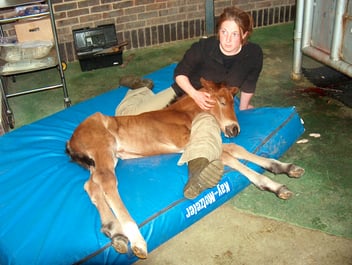Technique Tuesday - Placement of an indwelling feeding tube
For this Today's Technique, our co-founder and equine veterinary surgeon, Jennifer Corley, is sharing her expertise on the placement of an indwelling feeding tube. Have questions or comments? Drop them in the comment form below, and Jennifer will be more than happy to help! Stay tuned for more exciting insights and techniques.



Indications
Foals suffering from conditions like neonatal maladjustment syndrome can have difficulties in coordination leading to poor nursing activities. Foals may also require supplemental feeding when the dam has insufficient nutrition. An indwelling feeding tube can be the best way to achieve this while allowing the foal to continue to nurse as they can and avoid complications like pharyngitis.
Equipment
· 12Fr 108cm polyurethane foal feeding tube (eg MILA)
· 7.5cm (3 inch) wide stretchy adhesive dressing (Elastoplast)
· Two tongue depressors
· Zinc oxide tape
· Bandage scissors
· Endoscope (9mm diameter or smaller) or X-ray machine and plate
Technique
It is easiest to place the tube with the foal held in sternal recumbency or standing. The tube should be measured against the side of the foal (while keeping the tube clean). When placed the end of the tube should reach the distal oesophagus. To estimate this length the tube needs to run from the nares, following the approximate path of the oesophagus to around the 10th rib. Pre-mark the tube with the length you estimate needs to be passed.
In advance of tube placement, a device to secure the tube needs to be prepared. Measure a tongue depressor so that the curved end overlaps the nostril and the end reaches the facial crest. Reinforce this with a second tongue depressor and wrap in zinc oxide tape so there are no hard edges. The foals face should be wrapped with Elastoplast caudal to the nares. This bandage should be tight enough so there are no folds but not so tight it stops the foal opening its mouth or put any pressure on the nares. The end of the tube should be lubricated using water or KY jelly.
To pass the tube one arm is passed over the foal’s poll to hold the foal’s chin. The tube is passed into the ventral and medial aspect of the foal’s nostril. If there is resistance before the oropharynx the tune should be withdrawn and redirected. When the tube reaches the oropharynx it should be twisted 180 degrees and advanced until resistance is met. At this point it is important that the foal swallows the tube. This can be assisted either by gently moving forwards and backwards to stimulate the swallow reflex or by placing a gloved finger in the foal’s mouth to stimulate the suckle reflex. Advance to the pre-marked length and temporarily tape the tube in position. It is important to now confirm correct placement of the tube in the oesophagus. This can be done by:
1. Radiography.
2. Endoscopy.
3. Palpation of the tube in the oesophagus (less reliable).
Regardless of the method used the tube should be tested with a small amount of water to ensure there is no significant resistance to injection, which might indicate a kink in the tube. If the tube has kinked remove it and use a new one. Using the same tube will probably result in the same problem. Once the tube is correctly placed remove the stylet and secure.
Fixing a feeding tube in place
Take the prepared tongue depressor and starting at the end furthest from the nose wrap the tube along the bottom edge of it. Use the curve of the tongue depressor to secure the curve of the tube into the nostril (see illustration). The tongue depressor is then wrapped onto the preplaced Elastoplast. Once fixed the tube should be retested using 5ml of water. It is best to give fluids or nutrition by the tube by gravity. Enteral feeding bags are available or you can use fluid bags/administration sets. An alternative is to use the barrel of a 60ml catheter tip syringe connected to the feeding tube and fill this with milk. It is important to start with a small amount of fluid and gradually increase. The tube should be checked for reflux and position at every feed.




